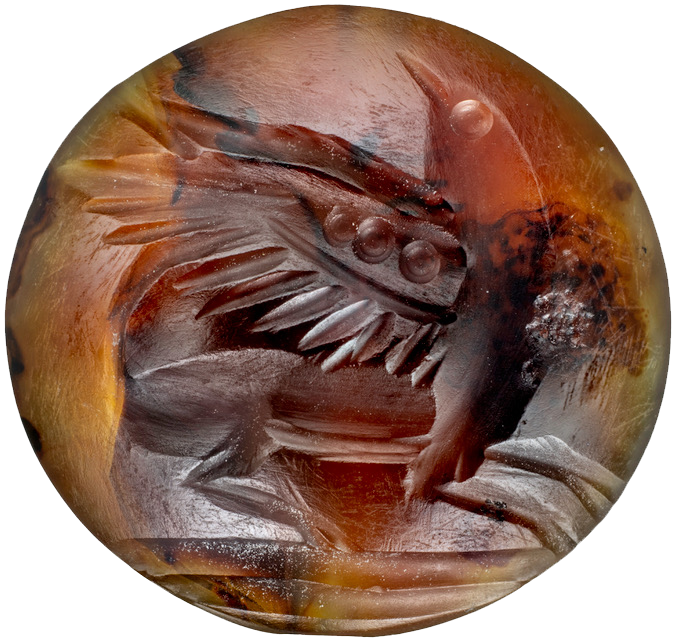Griffin Warrior Tomb
In May 2015 on the first day of renewed excavations at the palace, the team unexpectedly discovered a large, stone tomb. Hundreds of artifacts were found along with the body of a single male, the “Griffin Warrior.”
“The team did not discover the grave of the legendary King Nestor, who headed a contingent in the Greek forces at Troy. Nor did it find the grave of his father, Neleus. They found something perhaps of even greater importance: the tomb of one of the powerful men who laid foundations for the Mycenaean civilization, the earliest in Europe.”
In a previously unexplored field near the palace, the University of Cincinnati-sponsored team representing a dozen different nationalities and universities revealed the tops of the walls of a stone-lined shaft. As they continued to dig, they found that although most nearby Mycenaean graves had been looted in the past millennia, this one was remarkably intact. On the floor of the grave lay the skeleton of a single adult male surrounded by an enormous hoard of wealth, one of the most magnificent collections discovered in Greece in recent decades.
The dead man lay on his back with a meter-long sword, its hilt coated with gold, and gold-hilted dagger on his chest. Still more weapons were found by the man’s legs and feet, and other precious items surrounded him.


Gold cups rested on the warrior’s chest and stomach and by his right side were hundreds of carnelian, amethyst, amber, and gold beads. A gold chain and a pendent, dozens of seal-stones carved with intricate designs, and four gold rings glittered beside him. A plaque of ivory with a representation of a griffon in a rocky landscape lay between the man’s legs. Nearby was a bronze mirror with an ivory handle.
Other grave gifts had originally rested above the man, but they later spilled onto the body, crushing everything beneath them. These included bronze jugs, a basin, many perforated wild boar’s teeth from the warrior’s helmet, and thin bands of bronze, probably from his suit of body armor.
The warrior buried in the tomb was certainly a prominent—perhaps the most prominent—local leader of his generation. He ruled at the very beginning of Mycenaean civilization when the magnificent shaft graves excavated by Heinrich Schliemann were being used for the burial of Mycenae’s elite. He would have lived on the acropolis of Englianos by the palace at a time when mansions decorated with wall paintings first were being built with walls of cut-stone blocks in the so-called Minoan ashlar style. It is no surprise then that the majority of the 1500 or more objects with which he was buried are of Minoan style or Cretan manufacture.
“It is truly amazing that no ceramic vessels were included among the grave gifts. All of the cups, pitchers, and basins we found were of metal: bronze, silver, and gold. He clearly could afford to hold regular pots in disdain.”



The announcement of the discovery of the Griffin Warrior’s grave brought international attention to the project. Now, as the years pass, work continues on the tomb. The warrior’s wealth must be thoroughly conserved and documented for future research, which frequently reveals new details about the tomb and its contents.
If you are interested in supporting the continuation of this work, please consider making a donation.
“The last thing we expected to find was a Mycenaean shaft grave. It was good luck to discover it, almost as if its occupant wanted his story to be told.”
Significant Finds in the Griffin Warrior Tomb
Lord of the Gold Rings
Many of the grave goods were manufactured in the Minoan world. Among the gold artifacts were four signet rings decorated with Minoan ritual scenes. We have discussed the excavation of the grave, describe the rings, and consider the significance of the rings’ iconography for the Mycenaeans who buried them.
The Combat Agate
“The Pylos Combat Agate, in our view a Cretan work of Late Minoan I, may be the finest example of glyptic art yet discovered in a Minoan or Mycenaean context. It was found in 2015 in the grave of the so-called Griffin Warrior at Pylos. The face of the sealstone bears a representation of combat that draws on an iconography of battle scenes known from the Shaft-Grave period mainland and Neopalatial Crete. The level of detail in the representation of weapons and clothing, like the attention given to the physiognomy of the human bodies, is without parallel. We argue that the scene had special significance for the warrior and those who arranged his interment.”




